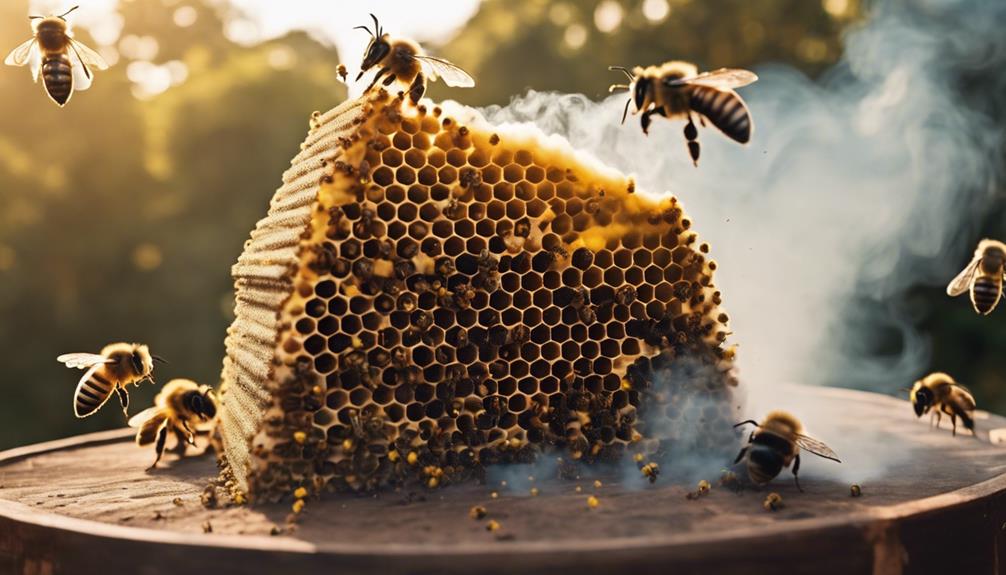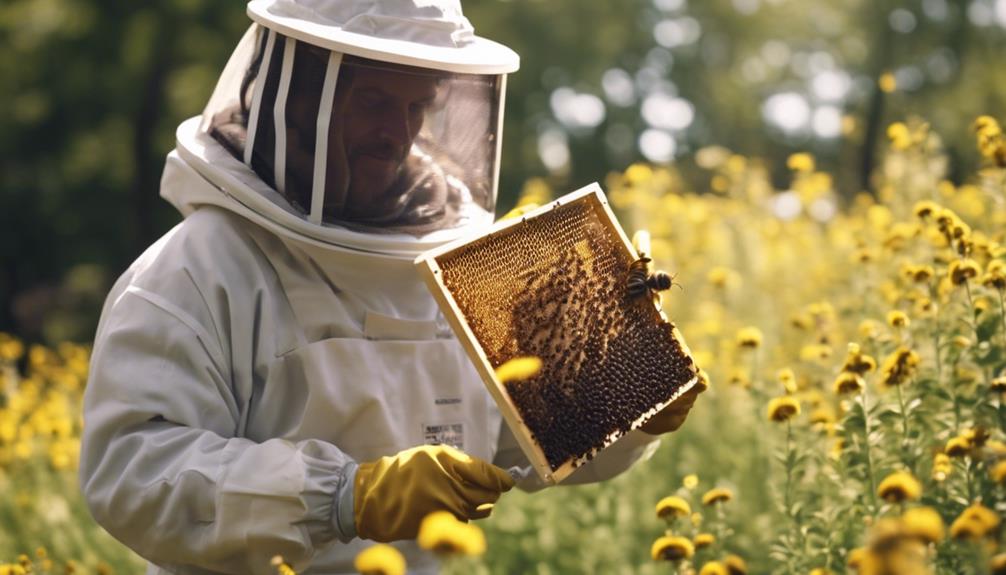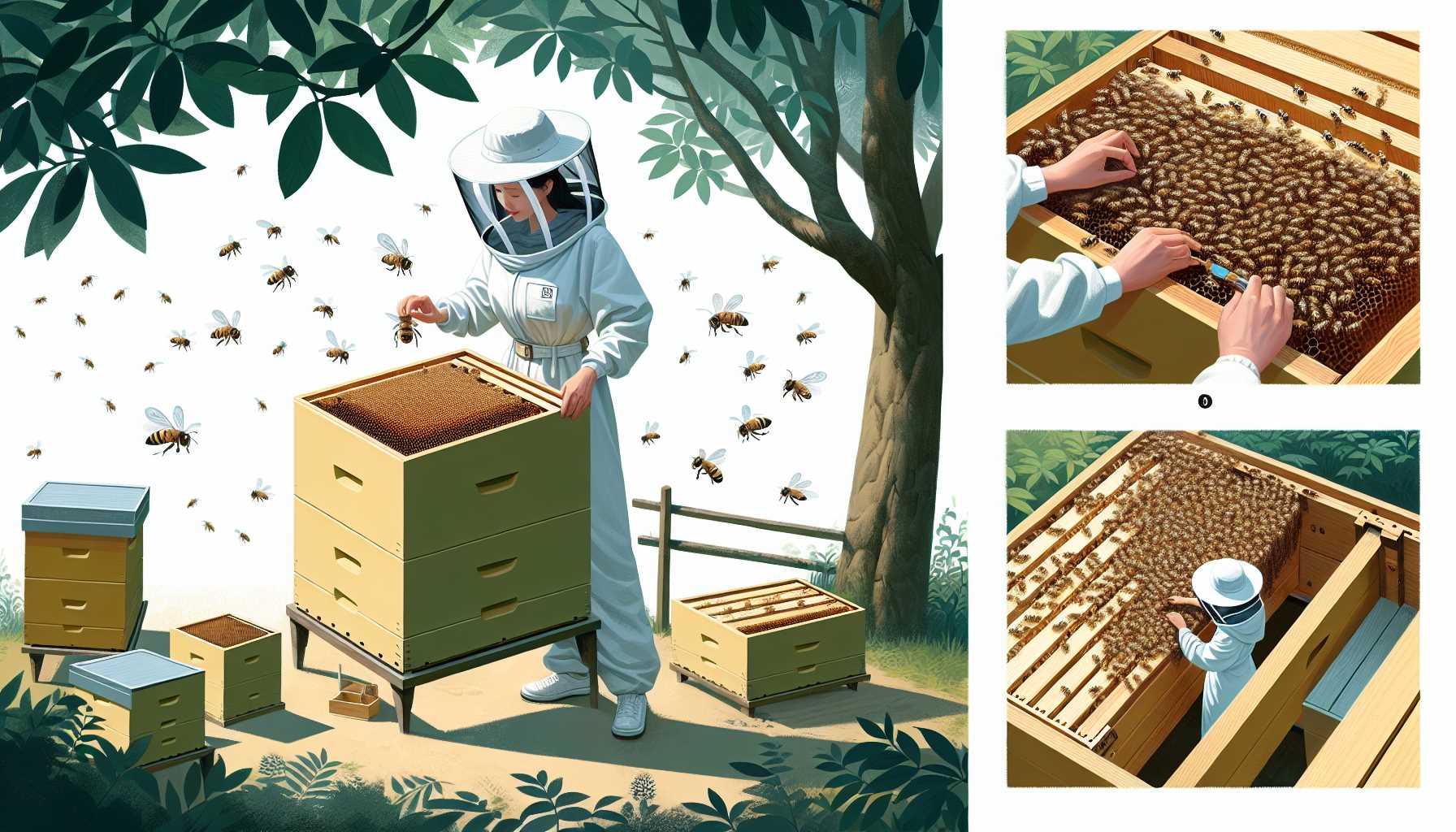Dealing with bees, utilizing smoke can work wonders. It actually helps keep them calm, making hive inspections much smoother and safer. The smoke masks their alarm pheromones, so they don’t go into full alert mode during the process. Plus, it’s fascinating how it makes bees focus on gorging honey instead of getting all defensive and stingy. And did you know that the cool smoke used doesn’t harm the bees? It’s all about creating a win-win situation. So, next time you’re buzzing around with bees, keep that smoke handy for a more peaceful coexistence.
Main Points
- Smoke masks bees’ alarm pheromones, calming them during hive inspections.
- Gorging on honey due to smoke reduces bees’ stinging behavior.
- Smoke disrupts bee communication, decreasing defensive responses.
- Cool smoke used in bee removal is safe and minimizes venom release.
- Smoking bees can aid in their evacuation from hives, enhancing beekeeping processes.
Benefits of Using Smoke on Bees
Using smoke on bees offers several benefits that contribute to safer and more efficient hive inspections. When we release the smoke, it masks the bees’ alarm pheromones, creating a sense of calm among the colony. This results in a more relaxed environment for us to work in, making the inspection process much smoother.
Additionally, the smoke causes the bees to gorge on honey, which makes them less inclined to sting us during the handling. By disrupting their communication, the smoke also reduces their defensive responses, further ensuring our safety.
It’s essential to note that the cool smoke we use doesn’t harm the bees, prioritizing their well-being while allowing us to manage their behavior effectively. The release of the venom is significantly minimized, making the entire experience more manageable for both the bees and us.
Types of Smokers for Bee Removal
When contemplating bee removal, understanding the different types of smokers available is crucial for effectively managing bee colonies. Here are some key aspects to ponder when selecting a bee smoker:
- Material: Bellows smokers are typically crafted from wood and leather, while stainless steel smokers offer durability and resistance to rust.
- Design: Various smoker designs offer different sizes of fuel chambers and nozzles to regulate smoke output efficiently.
- Preference: Stainless steel smokers are preferred for their durability and ease of cleaning compared to traditional bellows smokers.
- Selection: The appropriate smoker choice depends on personal preference, budget, and the scale of the beekeeping operation.
Having the appropriate bee smoker can make the bee removal process smoother and more efficient for both the beekeeper and the honey bees.
Safety Precautions When Using Smoke

Using safety precautions is vital when utilizing smoke near bees for removal purposes. Always remember to wear protective gear such as a bee suit, gloves, and a veil when dealing with bees and smoke.
Keeping a safe distance from the bees is essential to avoid provoking them while using the smoke. Additionally, make sure there’s proper ventilation to prevent inhaling any harmful fumes. It’s wise to have a fire extinguisher or water source nearby in case of any accidents with the smoker.
Pay attention to the wind direction to prevent the smoke from blowing back towards you or others. By following these safety measures, you can effectively use smoke to manage bees without putting yourself or others at risk.
Effectiveness of Smoke in Bee Control
Understanding how smoke can control bees, grasping their behavior is crucial.
We’ll delve into how smoke can conceal alarm signals and interfere with their communication, rendering it a potent tool.
Let’s also discuss the advantages of smoking bees and essential safety considerations to bear in mind.
Smoke and Bee Behavior
Without a doubt, smoke plays a pivotal role in bee control by masking alarm pheromones and reducing defensive responses in bees. When dealing with bees, understanding their behavior is key.
Here are four essential points to keep in mind:
- Smoke Masks Alarm Pheromones: By using smoke, we can confuse bees and disrupt their communication, making it harder for them to coordinate a defensive attack.
- Reduced Aggression: Bees tend to gorge on honey when exposed to smoke, leading to a more docile demeanor and decreased aggression levels.
- Ineffectiveness for Established Hives: Smoking out bees from well-established hives mightn’t be very successful due to their strong attachment to their home.
- Handling Swarms: Swarms, on the other hand, are usually less defensive and may not necessarily require smoke for control, but smoking them can complicate certain processes like extraction or euthanasia.
Benefits of Smoking
After understanding the role of smoke in bee behavior, it becomes evident that the benefits of smoking bees extend to effectively controlling their actions and minimizing defensive responses.
When we introduce smoke, it masks the alarm pheromones that bees release, which in turn calms them down and prevents aggressive behavior. This allows us to work around them without triggering a defensive reaction. Additionally, smoke prompts bees to prepare to leave their hive, making it easier for us to manage them during inspections or removal processes.
Safety Considerations
In considering safety considerations for using smoke in bee control, it’s crucial to understand the proper application techniques to guarantee the well-being of both bees and beekeepers. Here are four essential points to keep in mind:
- Controlled Usage: Always use smoke in a controlled and measured manner to avoid overwhelming the bees.
- Proper Ventilation: Ensure proper ventilation to prevent excessive smoke buildup in the hive.
- Monitor Bee Behavior: Pay attention to how the bees react to the smoke to gauge its effectiveness in calming them.
- Safety Gear: Wear appropriate protective gear to shield yourself from bee stings and potential smoke inhalation risks.
Tips for Successful Bee Removal With Smoke
To enhance the effectiveness of using smoke for bee removal, it’s vital to master the proper techniques. When dealing with bees, understanding their response to smoke actually plays a significant role.
Honey bees interpret smoke as a signal of a nearby forest fire, triggering a natural instinct to prepare for evacuation. This leads the bees to gorge on honey, making them less aggressive and more focused on survival rather than defense.
Impact of Smoke on Bee Behavior

When observing the impact of smoke on bee behavior, it becomes apparent that it plays a vital role in influencing their defensive reactions and communication within the hive. Here’s how smoke affects bees:
- Smoke masks bees’ alarm pheromones, calming their defensive response.
- Bees consume honey stores when exposed to smoke, preparing for potential relocation.
- Cool smoke doesn’t harm bees and disrupts their communication.
- Smoking bees in swarms can complicate extraction or euthanasia processes.
Understanding how smoke influences bees is essential for beekeepers looking to maintain hive health while ensuring the safety of the bees. By using smoke strategically, we can work in harmony with these fascinating creatures.
Best Practices for Smoking Out Bees
Using smoke strategically is key to safely and effectively managing bees during hive inspections and maintenance. Smoke masks guard bees‘ alarm pheromones, keeping them calm and less likely to sting.
When using smoke, remember to puff it at the hive entrance before opening to help prepare the bees and reduce defensive reactions. Bees tend to consume honey when exposed to smoke, which distracts them and lowers their aggression levels.
It’s essential to use smoke in moderation and handle the bees gently to maintain a stress-free environment for both the bees and the beekeeper. If you do get stung, smoking the affected area can help prevent further stings and safeguard safety.
Using Smoke to Relocate Bees

When relocating bees, using smoke plays a vital role in ensuring our safety and the success of the operation.
By calming the bees and disrupting their communication, smoke helps us handle these insects with greater ease.
The effectiveness of smoke in relocating bees can’t be overstated, making it an essential tool for beekeepers.
Safety When Smoking Bees
Safety precautions are crucial when utilizing smoke to relocate bees. Here are four key safety tips to keep in mind when smoking bees:
- Use the Right Equipment: Make sure you have a bee smoker designed for this purpose and keep a water source nearby in case of emergencies.
- Wear Protective Gear: Always wear appropriate beekeeping attire, including a beekeeping suit, gloves, and a veil to protect yourself from potential stings.
- Mind the Wind: Be mindful of wind direction when smoking bees to avoid inhaling excessive smoke or causing the bees to become agitated.
- Practice Good Technique: Use the smoke sparingly and gently puff it towards the bees to keep them calm without overwhelming them.
Effectiveness of Smoke
To effectively relocate bees, utilizing smoke is a proven method that masks alarm pheromones and encourages the bees to evacuate their hive. Honey bees are highly sensitive to smells, and when they detect smoke, they interpret it as a sign of a forest fire, triggering their instinct to leave the hive.
By using smoke, beekeepers can safely and humanely encourage bees to gorge on honey stores, preparing them for relocation without causing harm. This method not only helps in deterring bees without aggression but also facilitates their non-lethal transfer to a new location.
The effectiveness of smoke in bee relocation showcases a practical and efficient way to work harmoniously with these pollinators while respecting their natural behaviors.
Mistakes to Avoid When Smoking Bees
Using excessive smoke when tending to bees can harm the insects and disrupt their hive’s natural environment. To guarantee a safe and effective smoking process, here are some mistakes to avoid when smoking bees:
- Avoid Excessive Smoke: Using too much smoke can stress the bees and interfere with their normal activities.
- Use Cool Smoke Only: Hot smoke can cause burns to the bees and damage the hive structure.
- Mind Your Aim: Directing smoke at individual bees can trigger defensive behavior, increasing the risk of stings.
- Quality Fuel: Opt for high-quality, natural smoker fuel to prevent introducing harmful substances into the hive.
Alternatives to Smoke for Bee Removal

When considering methods for bee removal, exploring alternatives to smoke can offer a more natural and gentle approach to encourage bees to relocate. Honey bees play an important role in our ecosystem, and it’s essential to find ways to coexist peacefully.
Sting extension in honey bees can be triggered by smoke, causing them to become defensive. Instead of using smoke, try using garlic spray to repel bees or citronella candles to encourage them to leave without harm.
Peppermint plants or oil are great natural deterrents due to their strong scent, and sprinkling cinnamon in targeted areas can effectively keep bees away. These methods provide safe alternatives that respect the bees while addressing the need for their removal.

Hello! My name is Noel Calvin. I graduated from UCLA and now work as a writer at Launch Ninjas. I write blog posts that inspire and guide our readers in their entrepreneurial pursuits. I live in Pleasantville, NJ, with a peaceful yet lively atmosphere that inspires me.
Writing stories is more than just a job for me. It allows me to share my observations and satisfy my curiosity about the world. I combine my analytical skills with creative enthusiasm to delve into technology trends and startup stories. But my life isn’t limited to screens and keyboards. I value loyalty, passion, and a touch of old-fashioned charm, which I infuse into every narrative I create.
I love spending time in my garage, jamming with my band when I’m not writing. Playing the guitar and singing bring me immense joy. I also enjoy capturing ordinary and extraordinary moments through my camera lens and exploring new culinary adventures that excite my taste buds. I’m always seeking new experiences.
My family is very important to me. Joyful Sunday brunches filled with laughter and intense board game nights keep me grounded, reminding me of life’s simple pleasures.
In my world, every moment is an opportunity for discovery. Every discovery is a story worth sharing, whether a heartfelt moment at home or the pulse of technological innovations. Join me as I navigate through life, one blog post, one guitar strum, and one heartwarming family dinner at a time.


